|
|
Premiere. MiTAC – two PDAs based on Magneto, a new smartphone
and other devices
Very soon we expect an announcement of the new version of Windows
Mobile operating system. Our readers could have read the preview
of the operating system Windows
Mobile 5 (Magneto) long ago. Today we introduce 2 PDAs based
on the new OS version and some other interesting devices by Taiwan’s
company MiTAC. As they say – you read it first.
MiTAC releases own brand devices (Mio Tech) and devices for Medion.
There are plenty of local brands, which aren’t known outside the
country of their origin. In Russia it was Rover, but the company
ceased PDA sales abandoning this direction.
MiTAC started working with Pocket PC platform in 2001, there were
developments. In the end of 2002 the company released a winning
budget model MiTAC Mio338, which had no price competitors at that
time (HP iPaq 1910 and Dell X3 came out later). During 2003 MiTAC
launched the update for MiTAC Mio338 (the Mio 338 Plus and the Mio339
with the camera), a wireless MiTAC Mio558 and the Mio168 with built-in
GPS-receiver (satellite navigation). The success of this model and
the following Mio 136 (Win CE instead of Pocket PC) strengthened
company’s position on the PDA market, the sales growth amounted
in hundred percents. Already in 2003 the company saw the prospects
of the market for devices with built-in GPS-receiver, as satellite
navigation turned to enjoy great demand. But only by the end of
2005 other PDA makers will bundle most new models with built-in
GPS-receivers, that is one of the main trends in the industry.
Following the success of the Mio168 and the Mio136 the whole product
line was rearranged with the focus on GPS. Some projects remained
just projects, for example, the Mio LB (a monochrome screen, Bluetooth,
$150), the Mio 3G and some other projects. From the new products
we’ve seen a Win CE PDA Oscar 100 (the Mio 268/269), it’s popular
only within the Western Europe (with its own cartographical software,
maps not for all countries).
All new GPS products by MiTAC will involve SiRF STAR III chip by
GlobalSat. It’s the latest generation of GPS chips featuring lower
power consumption, a built-in ceramic antenna and high sensitivity.
To add, the products offered by rival companies and aren’t yet announced
will be based on the same chip, you can learn more details on the
maker’s
web site.

The Mio 168 (the review is
available on our site) has been recently updated, with the key
addition of SiRF STAR III chip. There are some minor changes in
design. In June 2005 the model will be moved from the market. Its
life cycle could have been extended till the 4Q 2005, but there
are problems with the availability of Intel PXA255 processors, the
production was cancelled (due to the shortage of these processors
plants are currently idle, no shipments are made, main company’s
products are based on this processor). In the 4Q 2005 there will
emerge the Oscar 150 to replace this model (the code name and the
exact commercial index aren’t disclosed yet). This is the top product
in the line. It is based on new Intel PXA 27x processor, supports
Bluetooth, new OS version (Magneto), an infrared port and a dual
expansion slot. It will hardly become the hit, as the Mio 168, by
the release date the competitors could offer products similar in
specs and functionality. The Oscar 150 will have a price tag of
$450-500 at the start, then the price will be adjusted considering
the competitors’ prices for similar products.
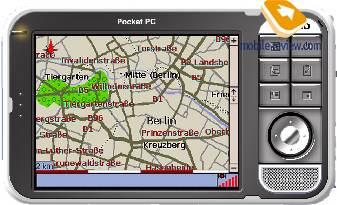
The budget Pocket PC GPS is the Oscar 98. It differs from the Oscar
150 in landscape control elements orientation, a single expansion
slot and the lack of Bluetooth. In common there will be Windows
Mobile Magneto and SiRF STAR III chip. The release is scheduled
for the 4Q 2005. I’d note, Asus is expected to launch a similar
device.
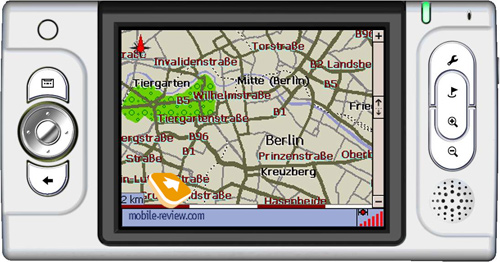
The Oscar 200 will replace the Mio 268/269. This isn’t a Pocket
PC, it works under Windows CE the fifth version. The dimensions
got smaller. In addition to GPS the company focused on multimedia
functions – MP3 and video playback. The GPS chip is SiRF STAR III.
The Oscar 200 will cost less than the Mio 268/269, but higher than
the Mio136.
In addition to GPS devices the company pays great attention to
the multimedia-oriented products. Some products were scheduled for
2004, but they have never been announced. The below-mentioned products
might have the same destiny and remain just projects.
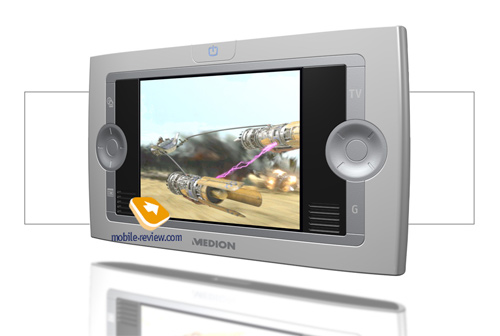
The Mio PT200 is a concept development based on the old operating
system, Windows Mobile 2003 SE. Unlike other products it is equipped
with an integrated digital TV receiver and non-standard control
elements. It’s quite a big device oriented on home use, which is
a narrow niche. The release is set for the early May, however these
dates are under question.
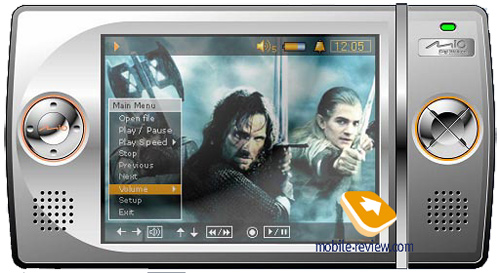
Here is an interesting development – the Mio PV150, let’s have
some details on it. It’s quite tiny (the diagonal makes up just
2.7”), there are a 1” 5GB hard dist and stereo speakers. The built-in
battery provides 3 hours of video playback and 12 hours of music
with the screen off. Expect this product in August 2005, the price
is not unveiled.
We’d mention another device, the Mio PV300 (the project Mio PEC),
it’s a Win CE analog of the Mio PT200, scheduled for the end of
2005. However we doubt in its appearance. It have been suspended
since the mid of 2004, and now it seems be put off. Main difficulties
are likely with the development of the hinged architecture of the
shell, like in Sony UX40/UX50 handhelds.
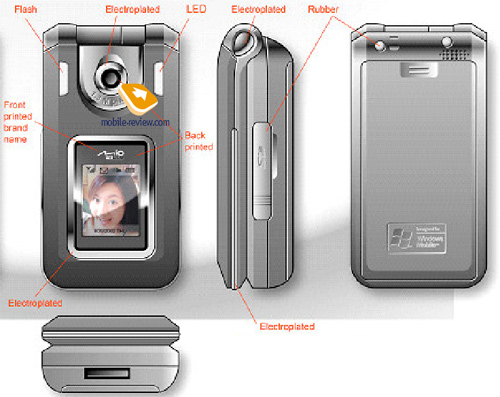

The last product in today’s list, but not of least importance though,
is the smartphone called the Kestrel (the commercial name is likely
the Mio A701). The smartphone is powered by Windows Mobile 2003
for Smartphone, featuring a QVGA screen (320x240 pixels), displaying
64K color in reality (262K claimed), a 1.3-megapixel camera with
flash, video recording opportunity (video during the incoming call).
The external screen has a 1.2” diagonal and made under TFT technology.
There are Intel PXA27x 312 MHz processor, an expansion slot for
microSD cards (our sample featured Intel PXA26x processor, an ordinary
SD/MMC slot, however there have been made changes during the development
process). The device supports Bluetooth and recognizes voices).
The battery is capacious of 900 mAh.
In near future we plan to publish the preview of the Mio Kestrel
and other products by MiTAC, which reached our test labs. Remember,
not all products will come out to the market, and the products that
will appear might be different in design and specifications, as
they aren’t officially announced.
Anton Kotov
(anton.kotov@mobile-review.com)
Translated by Maria Mitina (maria.mitina@mobile-review.com)
Published - 10 may 2005
Have something to add?! Write us... eldar@mobile-review.com
|
News:
[ 31-07 16:21 ]Sir Jony Ive: Apple Isn't In It For The Money
[ 31-07 13:34 ]Video: Nokia Designer Interviews
[ 31-07 13:10 ]RIM To Layoff 3,000 More Employees
[ 30-07 20:59 ]Video: iPhone 5 Housing Shown Off
[ 30-07 19:12 ]Android Fortunes Decline In U.S.
[ 25-07 16:18 ]Why Apple Is Suing Samsung?
[ 25-07 15:53 ]A Few Choice Quotes About Apple ... By Samsung
[ 23-07 20:25 ]Russian iOS Hacker Calls It A Day
[ 23-07 17:40 ]Video: It's Still Not Out, But Galaxy Note 10.1 Gets An Ad
[ 19-07 19:10 ]Another Loss For Nokia: $1 Billion Down In Q2
[ 19-07 17:22 ]British Judge Orders Apple To Run Ads Saying Samsung Did Not Copy Them
[ 19-07 16:57 ]iPhone 5 To Feature Nano-SIM Cards
[ 18-07 14:20 ]What The iPad Could Have Looked Like ...
[ 18-07 13:25 ]App Store Hack Is Still Going Strong Despite Apple's Best Efforts
[ 13-07 12:34 ]Infographic: The (Hypothetical) Sale Of RIM
[ 13-07 11:10 ]Video: iPhone Hacker Makes In-App Purchases Free
[ 12-07 19:50 ]iPhone 5 Images Leak Again
[ 12-07 17:51 ]Android Takes 50%+ Of U.S. And Europe
[ 11-07 16:02 ]Apple Involved In 60% Of Patent Suits
[ 11-07 13:14 ]Video: Kindle Fire Gets A Jelly Bean
Subscribe
|






